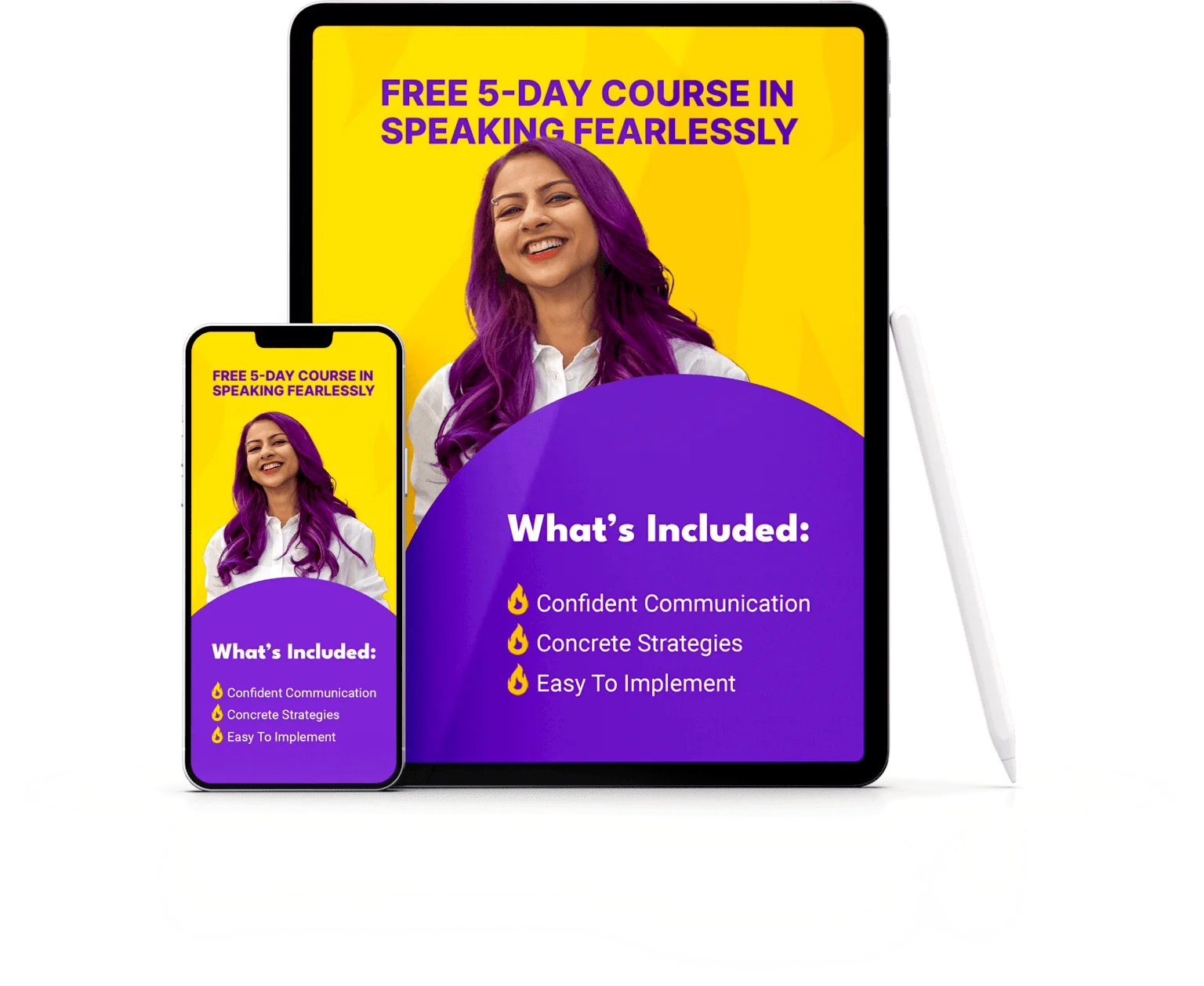The Power of Nonverbal Communication in Public Speaking
- Speaking tips , Presentations , Psychology
Public speaking is more than just the words you say. It’s about how you say them, how you connect with your audience, and the messages you convey through your nonverbal communication.
In this comprehensive guide, we will explore the significance of nonverbal communication , the key elements that make up nonverbal cues, and practical strategies to harness this power to become a more effective and persuasive public speaker .

Table of Contents

The Silent Language
Nonverbal communication, often referred to as “the silent language,” encompasses all the ways we convey information without using words. It’s a potent form of communication because it operates on a subconscious level, influencing how our message is received and interpreted by our audience.
This encompasses a wide range of cues, including:
- Body Language : Your posture, gestures and physical movements.
- Eye Contact : The way you make and maintain eye contact with your audience.
- Proximity : How close or far you are from your audience or other individuals on the stage.
- Appearance : Your clothing, grooming, and overall appearance, which can influence your audience’s perception.
- Use of Space : How you move around the stage or speaking area, including gestures and body positioning. This even includes how you use the frame on camera if you’re speaking online.
- Silence : The pauses and moments of silence in your speech, which can convey meaning and emphasis.
- Facial Expressions: We often have a poker face which does’t do much to enhance the message we’re aiming to convey. Facial expressions that go with the message can amplify your impact.

Photo by Natasha Hall on Unsplash
The Impact of Nonverbal Communication
Nonverbal communication plays a critical role in public speaking for several reasons:
1. Conveys Emotion and Authenticity
Your facial expressions, gestures, and tone of voice allow you to express emotions authentically. When your nonverbal cues align with your message, it adds depth and authenticity to your talk. For example, a smile can convey warmth and approachability, while a furrowed brow may signal concern or seriousness.
2. Enhances Message Clarity
Nonverbal cues can clarify your message, making it easier for your audience to understand and remember. Hand gestures can illustrate key points, and vocal variations can emphasize critical information. These cues act as signposts that guide your audience through your speech.
Pro-tip: if you over-do hand gestures or use repetitive ones, they can be distracting and damage your impact instead of enhancing it.
3. Builds Connection
Effective nonverbal communication helps you establish a strong connection with your audience. Maintaining eye contact, for instance, fosters a sense of engagement and rapport. A speaker who appears confident and approachable through their body language is more likely to connect with the audience .

4. Captures Attention
Engaging nonverbal cues can capture and maintain your audience’s attention. Movement, gestures, and vocal changes can add dynamism to your speech, preventing your audience from becoming disengaged or bored.
In a world where we’re constantly bombarded with notifications and urgent tasks, gaining attention is the real currency.
5. Demonstrates Confidence
Confidence is a quality that every public speaker should exude. Nonverbal cues such as upright posture, steady eye contact, and controlled body movements convey confidence to your audience. When you appear confident, your audience is more likely to trust and respect your message.
Key Elements of Effective Nonverbal Communication
To harness the power of nonverbal communication in public speaking, it’s essential to focus on specific elements and techniques. Let’s explore these key elements:
1. Body Language
Our posture, movements, and gestures are like an open book, revealing our emotions, confidence level, and authenticity. Here’s how body language can enhance or hinder your public speaking:
Posture : Stand or sit upright with your shoulders back. Good posture exudes confidence and presence. Conversely, slouching or crossing your arms can signal insecurity or defensiveness.
Gestures : Use purposeful hand gestures to emphasize points or convey information. Avoid excessive or distracting movements.
Movement : Move purposefully and with intent. Don’t pace nervously, but rather use movement to engage different sections of the audience or transition between points. Moving purposefully and making eye contact with your audience conveys that you’re fully engaged and interested in their response.
Note for speaking online : people often ignore movement and body language when speaking on camera. But in this context, it’s even more important to be more active and confident as the audience receives less information about your presence.
Enhance your on-camera body language by being aware of the frame, using gestures that are within the frame and being intentional with the frequency and variance of your gestures.
Credibility : Avoiding distracting movements, such as fidgeting, pacing excessively or swinging in your chair. This enhances your credibility as a speaker and shows that you’re grounded (literally!).

2. Eye Contact
Maintain Connection : Make eye contact with individuals throughout your audience to create a sense of connection and engagement. This is possible to do online as well – look into the camera instead of looking at yourself or your presentation.
Avoid Staring : Don’t fixate on one person or object for too long, as it can make your audience uncomfortable. Instead, distribute your gaze evenly.
Use of Notes : If using notes or slides, ensure you don’t rely on them excessively. Maintain eye contact while referencing your materials. Pro-tip: Don’t have full sentences on either your slides or your scripts. Have keywords instead and string together the sentences on the spot- this enhances improvisation and makes you sound fresh and natural.

3. Proximity
Your proximity to the audience and your use of personal space can create a sense of intimacy or formality:
Close Proximity: Stepping closer to the audience during a compelling point can create a feeling of closeness and connection.
This works in the online context as well – you’ll notice how the audience reacts when you lean in or when you sit back.
4. Appearance
Dress Appropriately : Your attire should align with the formality and expectations of your audience and the occasion. Dressing well can enhance your credibility.
When in doubt, go a bit more formal vs casual as a rule of thumb.
5. Use of Space
Stage Presence : Occupy the stage with confidence. Move with purpose, and use the space to engage different parts of the audience.
Avoid Excessive Movement : While movement is essential, avoid excessive pacing or aimless wandering, which can distract from your message.

Photo by Igreja Dimensão
Strategic Pauses : Incorporate strategic pauses into your speech to allow your audience to absorb information and emphasize key points.
There is a lot of power in the pause – use it liberally throughout your talk, presentation or podcast.
Control Filler Words : Minimize the use of filler words like “um,” “uh,” or “like.” Silence is preferable to fillers and indicates thoughtfulness.
7. Facial Expressions
Your face is a canvas of emotions, and your audience is keenly observing it. Expressions can either reinforce or contradict your spoken words:
- Smiling : A genuine smile can instantly connect you with your audience and convey warmth and approachability.
- Micro-expressions: You can say a lot with your expressions. Train your face to express emotions intentionally instead of leaving it up to the audience to insert their own emotions.
- Expressive Eyes : Your eyes can express enthusiasm, surprise, or concern, adding depth to your message.

Practical Strategies for Harnessing Nonverbal Communication
Now that we’ve explored the key elements of nonverbal communication, let’s dive into practical strategies for harnessing this power in your public speaking:
1. Practice, Practice, Practice
Effective nonverbal communication requires practice. Rehearse your talk or presentation multiple times, paying attention to your body language, tone of voice, and eye contact. Recording yourself can provide valuable feedback.
2. Audience Analysis
Consider your audience’s expectations, cultural norms, and preferences when it comes to nonverbal cues. Tailor your approach to resonate with your specific audience.
3. Get Feedback
Seek feedback from trusted colleagues, mentors, or speech coaches. They can offer insights into how your nonverbal cues are perceived and provide guidance for improvement.

Nausheen working with top female LinkedIn influencer Lara Acosta , giving feedback on her talk.
4. Use Visualization
Before your talk, visualize yourself delivering it with confidence and impactful nonverbal communication. Visualization can help reduce anxiety and boost your performance.
5. Mindfulness
Stay present and mindful while speaking. Be aware of your nonverbal cues and their alignment with your message. Correct any unintentional cues that may undermine your message.
6. Rehearse Transitions
Pay special attention to transitions in your speech. Smooth transitions with appropriate nonverbal cues can maintain your audience’s engagement and guide them through your message.
7. Record and Review
Record your speeches or presentations whenever possible. Reviewing the footage allows you to identify areas for improvement in your nonverbal communication. Build this as a part of your speaking and practice routine and you’ll grow your speaking skills exponentially.

8. Seek Role Models
Study accomplished public speakers and observe how they use nonverbal communication to enhance their message. Emulate their effective techniques.
Body language is underrated and super powerful as a tool in making you an impactful and memorable speaker.
Great non verbal communication can elevate your message and captivate your audience.
By mastering the key elements of body language , tone of voice, eye contact, appearance, use of space, and silence, and by implementing practical strategies for improvement, you can become a more effective and persuasive speaker.
Remember that nonverbal communication is not just an afterthought – it’s an integral part of the message itself. Embrace this power, and you’ll find that your impact as a public speaker transcends the spoken word alone.
If you want to work with an amazing coach who can guide you through this process of overcoming your stage fright , might I recommend myself? Find out how you can work with me and take advantage of my 10,000+ hours on stage and on camera to become a better speaker.

Nausheen I. Chen
Get a free 5-day course in speaking fearlessly, you might also like.
- Speaking tips
Choosing a Public Speaking Coach: What Most People Overlook
- public speaking , TED Talk
Unveiling the TED Talk Process: What You Don’t Know Yet
- Confidence , public speaking , Speaking tips
How to Make People Listen When You Speak: 5 Techniques You Haven’t Tried Yet
- Confidence , Psychology , public speaking , Speaking tips
The Best Mindset for Public Speaking: Why It’s Not What You Think
- fear of public speaking , public speaking
74% of People Fear Public Speaking: Here’s How to Beat Glossophobia
- public speaking , Speaking tips
Speak Like a TED Talk Speaker: 5 Powerful Techniques
Videos you might like, public speaking courses 101: how to choose the best course for your needs, “hello” 5 powerful strategies to introduce yourself in any presentation, public speaking tips: 6 powerful tips to influence people, how to create unforgettable videos as an entrepreneur, how to start your first podcast, build an amazing brand, and make money with podcasting, speaking in public: how to use the power of the pause for memorable talks.
Transform your speaking skills in 5 days. Sign up to find out how to turn your words into powerful, confident communication. This free video course will give you concrete strategies to gain more confidence and speak fearlessly at your next presentation, meeting or podcast.
By clicking the button above, you are agreeing to the terms outlined in our privacy policy .

Work With Me
Free resources, privacy & transparency.
- Privacy Policy
- Cookie Policy
© 2023 Nausheen I. Chen. All rights reserved.

How to Communicate Non-Verbally During Presentations
February 23, 2023 / Blog

Non-verbal communication is an essential aspect of conveying your message during a presentation. It can amplify your message by helping you connect with your audience, emphasize key points, and maintain the audience’s interest . Therefore, it is vital to develop your non-verbal communication skills to improve your presentation’s impact.
Need a Presentation Designed? Click Here To View Our Amazing Portfolio
Let’s talk about the best strategies for effective non-verbal communication during presentations.
Preparing for your presentation
Non-verbal communication is as important as verbal communication during a presentation. Thus, preparing for your presentation allows you to incorporate and optimize both verbal and non-verbal communication.
Here are some tips to help you prepare:
- Practice your body language and facial expressions in front of a mirror. You can also record yourself to review later. Being aware of your body language and facial expressions allows you to identify areas you need to improve.
- Dress appropriately for your audience and the message you want to convey.
Using body language
Body language lets you communicate through physical movements to convey messages and feelings.
However, while it can convey confidence, enthusiasm, and credibility, it can also undermine your message. Unprofessional body language can make you appear uncertain, uninterested, or untrustworthy.
Here are some tips to help you use your body language productively:
- Stand up straight to convey confidence, authority, and enthusiasm.
- Make and maintain eye contact with your audience. Make eye contact with individuals throughout the room, not just one individual or section.
- Use hand gestures to emphasize key points. Use gestures to indicate numbers or draw attention to specific areas of the slide.
- Use posture to convey your level of interest and engagement. Avoid slouching or leaning back, as doing so can make you appear disinterested and unprofessional, and may detract from your presentation.

Using facial expressions
Facial expressions can convey a range of emotions, attitudes, and reactions during a presentation. Using appropriate facial expressions can help your audience understand your message more effectively and engage them on an emotional level.
Here are some tips to use facial expressions effectively:
- Smile to show you’re friendly and approachable. Moreover, smiling can help you appear more confident and relaxed.
- Use a variety of facial expressions to convey different emotions.
- Avoid expressions that display discomfort, nervousness, or other negative emotions.
Effective non-verbal communication is an essential aspect of successful presentations. It can help you convey your message more effectively, connect with your audience, and keep them engaged.
By following the tips and strategies in this post, you can develop non-verbal communication skills to improve your presentation’s impact.
Partnering with SlideGenius can take the pressure off you as you prepare for your presentation. By handling the creation of visually appealing and informative presentation decks, SlideGenius can free up your time and energy to focus on the most important aspects of your presentation: preparing and rehearsing your delivery.
Contact SlideGenius today to schedule a consultation.
Popular Posts
Save your deck: methods to recover an unsaved powerpoint file.

Twitter: Lessons from Social Media

Oscar Speech Sounds A Lot Like…..

Olympians Can Teach Presenters a Thing or Two

Overcoming a Public Speaking Disaster: A Lesson from Michael Bay

The Similarities Between Presentations and Advertisments : Super Bowl Edition
- Bipolar Disorder
- Therapy Center
- When To See a Therapist
- Types of Therapy
- Best Online Therapy
- Best Couples Therapy
- Best Family Therapy
- Managing Stress
- Sleep and Dreaming
- Understanding Emotions
- Self-Improvement
- Healthy Relationships
- Student Resources
- Personality Types
- Guided Meditations
- Verywell Mind Insights
- 2024 Verywell Mind 25
- Mental Health in the Classroom
- Editorial Process
- Meet Our Review Board
- Crisis Support
10 Tips for Improving Your Nonverbal Communication
Kendra Cherry, MS, is a psychosocial rehabilitation specialist, psychology educator, and author of the "Everything Psychology Book."
:max_bytes(150000):strip_icc():format(webp)/IMG_9791-89504ab694d54b66bbd72cb84ffb860e.jpg)
Amy Morin, LCSW, is a psychotherapist and international bestselling author. Her books, including "13 Things Mentally Strong People Don't Do," have been translated into more than 40 languages. Her TEDx talk, "The Secret of Becoming Mentally Strong," is one of the most viewed talks of all time.
:max_bytes(150000):strip_icc():format(webp)/VW-MIND-Amy-2b338105f1ee493f94d7e333e410fa76.jpg)
Strong communication skills can help you in both your personal and professional life. While verbal and written communication skills are important, research has shown that nonverbal behaviors make up a large percentage of our daily interpersonal communication.
How can you improve your nonverbal communication skills? Paying closer attention to your nonverbal signals is an excellent place to start. You can also focus on factors such as tone of voice, eye contact, body language, and the context in which the communication occurs.
The following tips can help you learn to read other people's nonverbal signals and enhance your ability to communicate effectively. With practice, you can become more adept at conveying meaning without saying a word.
Pay Attention to Nonverbal Signals
People can communicate information in numerous ways, so pay attention to a variety of signals including:
- Body movements
- Eye contact
- Tone of voice
All of these signals can convey important information that is not put into words. For example, eye contact can help establish how attentive a person is. Tone of voice might reveal hints about their emotional state. Even posture can help convey how interested and engaged a person is in a conversation.
By paying closer attention to other people's unspoken behaviors, you will improve your own ability to communicate nonverbally.
Look for Incongruent Behaviors
You should pay careful attention if someone's words do not match their nonverbal behaviors. For example, someone might tell you they are happy while frowning and staring at the ground.
When words fail to match up with nonverbal signals, people often ignore what has been said and focus instead on unspoken expressions of moods, thoughts, and emotions . Therapists, for example, utilize these incongruencies to look for how a client might feel during a session.
So when someone says one thing, but their body language suggests something else, it can be helpful to pay extra attention to those subtle nonverbal cues.
Be aware that other factors might contribute to these differences. Physical challenges may affect a person's ability to convey signals, so consider other reasons why words and behaviors might not match up.
Focus on Tone of Voice
Your tone of voice can convey a wealth of information, ranging from enthusiasm to disinterest to anger. Tone can be an effective way to amplify your message.
Start noticing how your tone of voice affects how others respond to you and try using your tone to emphasize ideas that you want to communicate.
For example, if you want to show genuine interest in something, express your enthusiasm by using an animated tone of voice. Such signals not only convey your feelings about a topic; they can also help generate interest in the people listening to you speak.
Researchers have found that tone of voice can affect how people respond to healthcare practitioners. Patients report greater satisfaction when treated by surgeons who use a non-dominant tone of voice. People who use more vocal variety in tone of voice are rated as more trustworthy and attentive.
Use Good Eye Contact
Good eye contact is another essential nonverbal communication skill. When people fail to look others in the eye, it can seem as if they are evading or trying to hide something. On the other hand, too much eye contact can seem confrontational or intimidating.
While eye contact is an essential part of communication, it's important to remember that good eye contact does not mean staring fixedly into someone's eyes. How can you tell how much eye contact is appropriate?
Some communication experts recommend intervals of eye contact lasting three to four seconds. Effective eye contact should feel natural and comfortable for you and the person you are speaking with.
Ask Questions
If you are confused about another person's nonverbal signals, don't be afraid to ask questions. A good idea is to repeat back your interpretation of what has been said and ask for clarification. Some examples of this:
- "So what you are saying is that..."
- "Do you mean that we should..."
- "What I'm hearing is that you think..."
Such questions can help clarify a conversation and encourage the other person to keep talking. These questions are part of active listening and help demonstrate your interest and engagement in the conversation.
Sometimes simply asking such questions can lend a great deal of clarity to a situation.
For example, a person might be giving off certain nonverbal signals because they have something else on their mind. By inquiring further into their message and intent, you might get a better idea of what they are really trying to say.
Use Signals to Add Meaning
Remember that verbal and nonverbal communication work together to convey a message. You can improve your spoken communication by using body language that reinforces and supports what you are saying. This can be especially useful when making presentations or speaking to a large group.
For example, suppose your goal is to appear confident and prepared during a presentation. In that case, you will want to focus on sending nonverbal signals that ensure that others see you as self-assured and capable. You can strike a self-confident stance by:
- Standing firmly in one place
- Keeping your shoulders back
- Keeping your weight balanced on both feet
Matching your body language to your verbal messages can help convey greater meaning and clarify your intentions. Body movements and stance are important, but facial expressions, eye gaze, mouth movements, gestures, and personal space are also essential components.
Look at Signals as a Whole
Another important part of good nonverbal communication skills involves being able to take a more holistic approach to what a person is communicating. A single gesture can mean any number of things or maybe even nothing at all.
The key to accurately reading nonverbal behavior is looking for groups of signals reinforcing a common point.
If you place too much emphasis on just one signal out of many, you might come to an inaccurate conclusion about what a person is trying to say.
For example, imagine that a person sounds and looks confident in their words and body language, but you notice that they don't make much eye contact. If you were to base your assessment on eye gaze alone, you might conclude that they were anxious or unsure, when in reality, they are just tired or distracted.
Consider the Context
When you are communicating with others, always consider the situation and the context in which the communication occurs. Some situations require more formal behaviors that might be interpreted very differently in any other setting.
Consider whether or not nonverbal behaviors are appropriate for the context. If you are trying to improve your own nonverbal communication, concentrate on ways to make your signals match the level of formality necessitated by the situation.
For example, the body language and nonverbal communication you utilize at work are probably very different from the sort of signals you would send on a casual Friday night out with friends. Strive to match your nonverbal signals to the situation to ensure that you are conveying the message you really want to send.
Be Aware That Signals Can be Misread
According to some, a firm handshake indicates a strong personality while a weak handshake is taken as a lack of fortitude. This example illustrates an important point about the possibility of misreading nonverbal signals. A weak handshake might actually indicate something else entirely, such as arthritis.
Always remember to look for groups of behavior. A person's overall demeanor is far more telling than a single gesture viewed in isolation.
Interpreting nonverbal communication is complex and relies on various abilities, including interpersonal skills and emotional intelligence . Understanding that situations can be misread, different factors can affect how a person comes across, and the impact of your own biases can help you better interpret different nonverbal signals.
Practice, Practice, Practice
Some people just seem to have a knack for using nonverbal communication effectively and correctly interpreting signals from others. These people are often described as being able to "read people."
In reality, nonverbal communication is a skill you can improve. You can build this skill by paying careful attention to nonverbal behavior and practicing different types of nonverbal communication with others.
By noticing nonverbal behavior and practicing your own skills, you can dramatically improve your communication abilities.
Nonverbal communication is complex and varied. There's is no single approach or signal that is appropriate in every context. Being more aware of how nonverbal signals impact interpersonal relationships can help you learn to use nonverbal communication more effectively
A Word From Verywell
Nonverbal communication skills are essential and can make it easier to convey your point and to read what others are trying to tell you. Some people seem to come by these skills quite naturally, but anyone can improve their nonverbal skills with practice.
Park SG, Park KH. Correlation between nonverbal communication and objective structured clinical examination score in medical students . Korean J Med Educ . 2018;30(3):199-208. doi:10.3946/kjme.2018.94
Foley GN, Gentile JP. Nonverbal communication in psychotherapy . Psychiatry (Edgmont) . 2010;7(6):38-44.
Hietanen JK. Affective eye contact: an integrative review . Front Psychol . 2018;9:1587. doi:10.3389/fpsyg.2018.01587
Jarick M, Bencic R. Eye contact is a two-way street: arousal is elicited by the sending and receiving of eye gaze information. Front Psychol . 2019;10:1262. doi:10.3389/fpsyg.2019.01262
Scientific American. Eye contact: how long is too long ?
Pádua Júnior FP, Prado PH, Roeder SS, Andrade EB. What a smile means: contextual beliefs and facial emotion expressions in a non-verbal zero-sum game . Front Psychol . 2016;7:534. doi:10.3389/fpsyg.2016.00534
Tipper CM, Signorini G, Grafton ST. Body language in the brain: constructing meaning from expressive movement . Front Hum Neurosci . 2015;9:450. doi:10.3389/fnhum.2015.00450
Foley GN, Gentile JP. Nonverbal communication in psychotherapy. Psychiatry (Edgmont) . 2010;7(6):38–44.
Kret ME. Emotional expressions beyond facial muscle actions. A call for studying autonomic signals and their impact on social perception. Front Psychol . 2015;6:711. Published 2015 May 27. doi:10.3389/fpsyg.2015.00711
Evola V, Skubisz J. Coordinated Collaboration and Nonverbal Social Interactions: A Formal and Functional Analysis of Gaze, Gestures, and Other Body Movements in a Contemporary Dance Improvisation Performance. J Nonverbal Behav . 2019;43(4):451–479. doi:10.1007/s10919-019-00313-2
By Kendra Cherry, MSEd Kendra Cherry, MS, is a psychosocial rehabilitation specialist, psychology educator, and author of the "Everything Psychology Book."
Delivering your speech: the power of nonverbal communication
When I say “public speaking” what comes to mind? Dread? Nervousness? Excitement? “Public speaking” often brings uneasy feelings to first year students, as standing in front of a classroom ranging from first year to fourth years may seem a lot more intimidating than one full of your long-time high school classmates. You have a well-written and researched speech and you have already sought out a peer review from the Writing and Communication Centre, but the easy part is over. Delivering your speech involves more than a professional tone and a confident voice; you will convey the real impact of your message through nonverbal communication. Nonverbal communication is the communication we engage in that isn’t written or spoken language, but still creates meaning.
Eye contact, one of the most important nonverbal cues, keeps your audience engaged, makes you believable, and opens up communication. Looking at individual members of the audience establishes an interpersonal connection with them. While maintaining eye contact is important, gestures are useful when emphasizing certain points. Gestures are an excellent way to channel your nerves into movement, as long as you ensure they are not repetitive or taking away from your message. Using immediacy behaviours, that is, literally or psychologically making your audience members feel closer to you, can establish more relationships as a speaker. Moving closer to your audience or smiling are simple ways to create a closer relationship between you and your listeners.
The audience sees your face before they are going to hear your voice and thus, you have the opportunity to set an emotional tone before you even start speaking. As a speaker, you can decide how your facial expression can alter the atmosphere of your speech in a meaningful way. In many instances, audience members will mimic your emotions, so if you want your audience to feel a certain emotion, its best to express that emotion yourself. Although your face and voice play a major role in communicating a specific emotion, your posture will communicate the intensity of that emotion.
You might be overwhelmed at the long list of unconscious habits to consider when delivering a speech. Delivering a hard hitting, persuasive or informative speech is not easy, but it is an important and useful skill for your post-secondary education and beyond. If you need ideas, feedback, or strategies in creating and delivering a speech, the Writing and Communication Centre is a hub for practice, development and collaboration that can work with you to help develop your individual voice in your academic work. With practice, knowledge and a bit of help, public speaking does not have to be a daunting task, but an opportunity to share your ideas and leave a memorable impression as a speaker.
- communication ,
- public speaking ,
- nonverbal communication ,
- Writing and Communication Centre ,
- Current students ,
- Current undergraduate students ,
- Current graduate students ,
- Future students ,
- Future undergraduate students
- Member Login
- Board Login

Nonverbal Communication: Presentation Tips in a Virtual Workplace
by Tory Freeman | Jun 11, 2021 | General , Personal Development | 0 comments

With COVID-19 making many conferences, meetings, and businesses operate remotely, it is likely in the last 12 months you have had to: 1.) become a Zoom expert, 2.) repaint the wall behind your desk so it looks attractive, and 3.) invest in a high-tech microphone and camera. If all of this wasn’t stressful enough, presenting online gives us other challenges, including the horror of being able to see our own faces while we present, adding more stress to an already stressful situation. Speaking or presenting online gives other difficulties as well, as you have to think about how you show emotion through the camera, create connection remotely, pose with camera angles, and what you do with your hands.
Why Nonverbals are Important
Being able to connect using compelling nonverbal communication is powerful and a necessary part of any presentation, meeting, or sales interaction. Nonverbal communication is the other part of the communication equation, in which verbal and nonverbal communication are the two parts of the whole. Excellent communicators utilize both, and when presenting in virtual settings, it’s not just the words you say, but the manner in which you say them — the nonverbal communication that accompanies them can often speak louder than words. Dr. Kory Floyd, a Professor of Communication at the University of Arizona, defines nonverbal communication as “comprising any behaviors with which we communicate without the use of words.” These would include eye-contact, physical appearance (including clothes, or accessories such as glasses), body movement, gestures, facial expressions, and vocal variety. “Vocal variety” comprises the ways in which you use your voice, such as rate, pitch, pauses, and volume. Utilizing nonverbal communication can make a bland presentation come alive, give flair to a TED Talk, or create connection with your audience during a meeting.
That’s really the power of nonverbal communication — connection. To make us feel connected or close to someone. This phenomenon is often studied in instructional or business settings, and is called nonverbal immediacy . Dr. Floyd says, “Nonverbal immediacy is the use of nonverbal behavior to minimize psychological distance and create emotional closeness between people. It is useful in any setting (virtual or not) in which a sense of closeness is desirable. It can be achieved through eye contact, warm facial expressions and vocal tones, forward leaning, proximity, touch, and other behaviors that help to create or maintain connection between people.”
It is a worthy goal to try to increase nonverbal immediacy when interacting and presenting online, as it will help your audience to feel connected to you.
Sara Blakely, founder & CEO of Spanx, is magical at utilizing nonverbal immediacy. In this interview , she smiles warmly, uses a lot of eye-contact with the host, has a large range of gestures, laughs, and makes the audience absolutely fall in love with her. The good news is that you can make the audience connect with you by utilizing these following four types of nonverbal communication.
1.Facial Expressions
2. eye contact.
“The most important advice is to look at the camera, not at the image,” says Dr. Floyd, who suggests it’s important to vary your gaze whether in person, or remote.
3. Body Movement and Gestures
4. vocal variety.

Public Speaking: Nonverbal
Criteria for success.
- You feel confident in your movements and body posture.
- You maintain eye contact and forward-facing movements during the talk.
- You incorporate power poses when necessary.
- Your body movements flow naturally with your presentation and slides.
- Any movement that doesn’t support your main message is minimized.
Identify your purpose
A public presentation is more than just presenting information, it is also about engaging the audience and captivating their attention. If it wasn’t through our physical engagement, we might as well give the audience members an audio recording or slide deck instead. As a presenter, we attempt to liven the verbal messages with nonverbal gestures. Whether through body language, movement, or stage presence, these nonverbal components are just as important as the slides and talk you have practiced and prepared for. Incorporating conscious movements that serve to enhance how your message is perceived by your audience can help you:
- Engage your audience. Posture, gestures or movements, and your physical location on the stage are all factors that can be incorporated to create a story-telling effect that will keep your audience engaged throughout your presentation.
- Feel more confident. Strong body postures (e.g., power poses) convey confidence and a sense of importance during your talk.
Analyze your audience
Many audience members will arrive with the intention of learning more about your work and gaining some insight about your field. You can do more by also delivering an impactful and engaging talk that viewers can take home and remember. Audience types will dictate how you present yourself. For example, formal talks require formal attire, and this is also true in the types of nonverbal communication you can incorporate. Defined posture and deliberate movements are a must for professional talks, whereas more dynamic movements may be appealing for more casual and friendly presentations.
Similarly, the environment in which you are presenting will also determine your style. Poster presentations can be more informal with casual movements to guide the viewer. Department talks, on the other hand, should have movements that flow fluidly with your talk to guide the audience in your longer discussions.
Use eye contact to engage your audience
Possibly one of the most intimidating aspects of a talk is to look at the audience and to see their eyes gazing back at you. It is very common to escape eye contact by looking at your notes, the floor, or turning your back on your audience to face your slides. However, to be an effective presenter it is necessary to overcome these crutches in order to engage your audience. Making eye contact will help the audience feel important, like you are actually talking to them and not just giving a rehearsed speech.
If you already feel comfortable maintaining eye contact, remember to engage the entire audience. A few suggestions are:
- If it’s a large room, turn your head or even body to talk to all corners of the room, not just the people in the middle.
- Rather than just scanning the audience, can you take time to make one-on-one eye contact with individuals? Use this as an opportunity to gauge the audience’s level of interest. Seeing how they respond to your slides, transitions, etc. can help you adjust your talk as you go.
If making eye contact is challenging for you, here are two suggestions to help you work on this skill:
- Rather than trying to make eye contact with individuals, try looking at someone’s forehead, a colorful shirt, or the cushion of someone’s seat to create the illusion that you are making eye contact with the general audience. Alternatively, if picking out details is too distracting, you can look at or just above people’s heads to give the illusion of making eye contact.
- Once you feel comfortable looking into the audience, pick one or two places and go back and forth between these places during your talk to engage the entire room.
Emphasize deliberate movements and minimize unnecessary distractions (maximize signal-to-noise)
Here, we define signal as any movements that add substance to your talk and further engages the audience, such as conveying a message with your hands, or making eye contact with the audience.
Noise, on the other hand, is any unnecessary movements that distract the viewers, such as fidgeting or repetitive motions. Move with purpose. Do not ruffle your pockets or rock back and forth. Instead, present a straight, upright posture with arm movements that match the pace and flow of your talk. Adding purposeful movement to signify changes in ideas or to emphasize important points can add another layer of engagement to your talk. Some examples include:
- If you are comparing two concepts, physically weigh them out with your hands to convey the difference as if your hands were a scale.
- Casually walk to the other side of the stage when transitioning between ideas to physically cue the viewers that there is a change in topic.
- With a straight arm, point in the direction of the slide that has an important message. Make your movement distinct to indicate that the audience should focus on the slide, and not you.
Overall, this “art form” is unique to each person based on level of comfort and ability. We highly recommend using the Communication Lab to ask about how you can best utilize body movements to further enhance your talk. Alternatively, ask a friend for feedback, film yourself, or practice in front of a mirror to get a sense at what actions you naturally do during a talk, and reflect on how to change or enhance them.
(The metaphor of “signal-to-noise ratio” comes from Jean-luc Doumont’s book Trees, Maps, and Theorems .)
Use good posture and incorporate power poses
Many of us are rarely conscious of our posture, yet this is the first impression you will make to your audience even before you speak. A straight back and a level chin with your eyes facing the audience will show that you are prepared and ready.
Power poses can help assert confidence and importance during your talk. You are, in fact, the most important person in the room, so use power poses to make it look that way! What makes power poses distinct from low-power (or submissive) poses is the control of space. Hands on the side and a slightly wider stance command space on the stage and demands attention. Of course, overly dramatic, arrogant, or otherwise off-putting stances and posture should be avoided. Use a friend or video to find a power pose that makes you feel confident but doesn’t detract from your overall talk.
How to Practice
Non-verbal engagement is part of our daily lives, so pay attention to your movements when you interact with friends or co-workers. With practice, you will be able to naturally deliver a strong presentation when the time comes. Overall, things to consider are:
- Be conscious of your posture when standing and interacting with friends.
- Look people in the eye! Attempt to make eye contact with those you talk to.
- Pay attention to your small and fidget-like movements, even while by yourself. If these unwanted habits go unnoticed during everyday life, you can expect these habits to creep into your talk without you knowing.
Finally, make an appointment with the Comm Lab if you ever want to practice one-on-one or to discuss your concerns related to your non-verbal presentation style.

Additional Resources
- Common Challenges and Fixes for Verbal and Nonverbal Communication – An extensive reference table created by the BE Communication Lab
- “The Importance of Nonverbal Communication” – A quick read with fun statistics about the importance of nonverbal communication and additional concrete suggestions for improving your skills.
- “Your Body Language May Shape Who You Are” – A TED Talk on the effects of power poses and how to incorporate them into your daily life.
+1 (603) 932 7897

8 Nonverbal Tips for Public Speaking
- Last modified 2024-03-29
- Published on 2021-05-14

Nonverbal tips help students significantly in communication because nonverbal communication and verbal communication are the two core components of public speaking. While verbal communication can be improved with extensive practice, nonverbal communication directly impacts the audience’s ability to comprehend the message. Every gesture, from the movement of your hands to eye contact, will send different signals to the audience about your capabilities and understanding of the subject. Imagine, if you see a public speaker who delivers their point coherently and comprehensively, what will you think if they keep looking down or sideways, and put their hands behind their back?
Albert Mehrabian once wrote about the importance of verbal and non-verbal messages. He found out about the 7-38-55 rule : our words convey 7% of the meaning, our tone 38%, and our body language provides 55% of what the audience will remember.
Nonverbal language is hard to control, especially when you are too focused on presenting. Therefore, to help you be aware of your nonverbal cues and improve your body language and eye contact for future group presentations, here are eight nonverbal tips for you. We will discuss nonverbal communication in two forms: body language and tone.
Body language
1. the power pose by amy cuddy.
Amy Cuddy, the US social psychologist, suggests the “powerful pose” – spreading your arms wide and looking confident – to help people feel more powerful. According to her research with Harvard University, “ those who sat on the high-power pose, felt more powerful and had performed better in mock interviews than those who had not .” Our body influences our mind; therefore, by making the power pose, we feel more powerful and become more confident.
2. Maintain consistent breathing
The second nonverbal tip is focused on breathing. Breathing is essential in the public speaking setting. Breathing is often an undervalued and underrated method in public speaking, even though proper breathing will help you with your vocal control, pitch, and tone. For many people who have a fear of public speaking, research indicates breathing is correlated with speech anxiety. Speech anxiety causes shallower breathing: the less air we inhale, the shorter we can talk, and the less effective the presentation will be.
Before starting to speak, remember to take a deep breath by inhaling and exhaling for a quick second. This nonverbal tip allows the audience to have a short mental break before listening to your following sentence. There are multiple breathing exercises on the internet, such as from Harvard Business Review , to help you control your breathing while speaking as well.
3. Use proper hand gesture to enhance your message and improve confidence
Pay attention to where your hands are and what you are doing with them . Besides PowerPoint, Prezi, Keynote, and other presentation tools, your hands are a great way to communicate and illustrate your point of view to the audience. Using hand gestures communicates with the audience and helps them memorize better.
4. Movement - Moving your body around the stage
5. make eye contact with everyone in the audience, 6. control your voice with proper breathing, 7. consistency in public speaking.

8. Having a variety of vocal
According to research , TED speakers delivering the most popular talks had 30.5% higher vocal variety. Having vocal variety will help you speak in an expressive and energized way, while helping the audience maintain interest for the whole speech. Memorizing a script and speaking like a script will turn the audience off and make them lose interest, because monotone = boring. We suggest you remember the main points of your speech, then allow for some spontaneity and flexibility in your actual presentation. In addition, depending on the environment of the stage or the amount of audience, have a higher vocal variety because the audience may have a hard time hearing you.
Practice public speaking with Aralia College Accelerator Program
Aralia College Accelerator Program offers a diverse range of public speaking classes designed to nurture profound interests and improve their public speaking skills. Our classes cover various aspects of effective communication, including persuasive techniques, audience engagement strategies, and speech delivery mastery.
The accent reduction course focuses on understanding and strengthening the unique sounds and structures that make up the “neutral” dialect. While there are many dialects throughout America, it is the neutral accent commonly practiced by public speakers and officials. Radio DJs, TV news anchors, and even most Hollywood movie actors use the neutral accent to convey their message to the largest group of Americans possible. By eliminating accents in communication, we can more easily connect to our audience and erase any misunderstandings or unconscious bias from a foreign dialect, whether domestic or international.
In this English Speaking course, each class will focus on different topics: sports, volunteer experience, current affairs, politics, culture, education, literature, technology, and the environment. These various themes are based on real situations that students will encounter when they come to the United States. Learning to discuss these topics will be very useful when interacting with native English speakers. Students will build a solid foundation in oral expression and learn how to express themselves confidently and clearly in English.
This Public Speaking and Debate class will offer the opportunity to speak and listen to others talk only as much as possible. We will alternate between learning the structure of different types of speeches and making presentations by one student to the rest of the class. After each speech by students, we will have a critique from the peers, and the teacher. They will also be required and coached on how to participate in the discussion and to critique their peers.
- Academic Tips , Public Speaking

Interested in learning more?
Aralia Education is an innovative online education platform for ambitious middle and high school students worldwide. Aralia’s instructors propel students forward by helping them build a strong foundation in traditional academic courses. They also actively engage and guide students in exploring personal interests beyond their school curriculum. With this holistic approach, Aralia ensures its students are well-prepared for college and equipped for success in their future careers.
- College Accelerator Program
- Comprehensive Introduction to High School
- Academic Empowerment Program
- Test Preparation Bootcamp
- Private Lessons
- Student Awards
- Competitions
Give us a call: +1 (603) 932 7897
Email us: [email protected]
Add us on WhatsApp:


How it works
Transform your enterprise with the scalable mindsets, skills, & behavior change that drive performance.
Explore how BetterUp connects to your core business systems.
We pair AI with the latest in human-centered coaching to drive powerful, lasting learning and behavior change.
Build leaders that accelerate team performance and engagement.
Unlock performance potential at scale with AI-powered curated growth journeys.
Build resilience, well-being and agility to drive performance across your entire enterprise.
Transform your business, starting with your sales leaders.
Unlock business impact from the top with executive coaching.
Foster a culture of inclusion and belonging.
Accelerate the performance and potential of your agencies and employees.
See how innovative organizations use BetterUp to build a thriving workforce.
Discover how BetterUp measurably impacts key business outcomes for organizations like yours.
A demo is the first step to transforming your business. Meet with us to develop a plan for attaining your goals.

- What is coaching?
Learn how 1:1 coaching works, who its for, and if it's right for you.
Accelerate your personal and professional growth with the expert guidance of a BetterUp Coach.
Types of Coaching
Navigate career transitions, accelerate your professional growth, and achieve your career goals with expert coaching.
Enhance your communication skills for better personal and professional relationships, with tailored coaching that focuses on your needs.
Find balance, resilience, and well-being in all areas of your life with holistic coaching designed to empower you.
Discover your perfect match : Take our 5-minute assessment and let us pair you with one of our top Coaches tailored just for you.

Research, expert insights, and resources to develop courageous leaders within your organization.
Best practices, research, and tools to fuel individual and business growth.
View on-demand BetterUp events and learn about upcoming live discussions.
The latest insights and ideas for building a high-performing workplace.
- BetterUp Briefing
The online magazine that helps you understand tomorrow's workforce trends, today.
Innovative research featured in peer-reviewed journals, press, and more.
Founded in 2022 to deepen the understanding of the intersection of well-being, purpose, and performance
We're on a mission to help everyone live with clarity, purpose, and passion.
Join us and create impactful change.
Read the buzz about BetterUp.
Meet the leadership that's passionate about empowering your workforce.

For Business
For Individuals
What is nonverbal communication? 10 different types (with examples)

Jump to section
What is nonverbal communication?
10 types of nonverbal communication, examples of nonverbal communication, why is nonverbal communication so important, 5 tips for understanding nonverbal communication, how to improve nonverbal communication, enjoy better interactions.
We all rely on nonverbal communication. This is true whether playing a game of charades with your family or trying to show confidence during an important interview .
There’s a reason many of us prefer face-to-face communication over phone calls. Without seeing someone’s facial expressions, posture, and body language , it can be hard to read their feelings.
Nonverbal cues are just as important as verbalization. Nonverbal actions are key for communicating with and understanding everyone in your life.
Understanding every type of nonverbal communication can also help your career. You can show your confidence, passion, and expertise through small nonverbal communication cues. This is true whether leading a team meeting or delivering a presentation .
There are two primary forms of communication: verbal and nonverbal.
Verbal communication uses words to convey a message, whether that’s orally or in writing.
Posture, facial expressions, and eye contact are examples of nonverbal messages . We all use these cues in daily conversation, even involuntarily. Nonverbal communication also involves the way we present ourselves to others. If you walk into a meeting with your back straight and your head held high, you exude power and confidence. You project nervousness and uncertainty if you’re slumped over with your eyes on the floor.
Experts believe that approximately 70% of all human communication is nonverbal , meaning we only deliver about 30% of our messages with words.
Austrian-American author and educator Peter Drucker had it right when he said, “ The most important thing in communication is hearing what isn’t said. ”
We all perform and respond to nonverbal communication — and what we understand that no one says — daily.
Here are 10 of the most common forms of nonverbal communication:
1. Facial expressions
The look on an individual’s face is often the first thing we see. A smile, frown, or grimace tells a lot about their mood and how the subsequent conversation will go. Expressions of happiness, sadness, anger and fear are universal emotions and key forms of nonverbal communication.
2. Kinesics
Kinesics, or gestures, are conscious body movements like waving, pointing, and giving a thumbs up or down. One's culture typically determines what gestures are socially acceptable and which are rude.
For example, in Westernized countries, glancing at your watch suggests, “I need to be somewhere.” In contrast, many Middle Eastern populations consider this rude. They are more likely to believe a conversation should continue until it ends naturally.
3. Paralinguistics
Paralinguistic s (or vocalics) refers to the aspects of verbal communication that aren’t the words themselves . Your tone of voice, loudness, and pitch are common aspects of paralanguage.
This type of communication is powerful since altering your voice changes the meaning of a sentence. Think about all the ways you can use the phrase “I’m fine.” If you say it quietly, you might be feeling dejected, but if you say it forcefully, someone might detect your defensiveness.
4. Body language and posture
Crossing your legs or arms, a head nod, slouching, or sitting up straight are all examples of true body language. For example, you may have seen crime films focus on body language to further the narrative. It can also hint at what isn’t included in the dialogue.
However, this type of nonverbal communication is complex and quite subtle. Just because you observe a movement doesn’t guarantee you understand the meaning.
5. Proxemics
Proximity references how near something is. Human beings take personal space seriously. They also interpret physical distances in interactions differently.

Social and cultural expectations, personal preferences, and relationships all determine the suitable proximity. For example, if you’re in a relationship with someone, you’d expect to sit close together on the couch. On the other hand, you likely wouldn’t sit that close to a coworker.
Proxemics is an important part of interpersonal communication. Noticing when to adjust your closeness for each situation ensures you’re not making people uncomfortable.
Scientists focused on proximity biases in North America have grouped expected space as follows :
- Intimate space: Close physical contact up to 18 inches of space, typically shared between people in an intimate relationship.
- Personal space: Between 18 inches to 4 feet depending on whether you’re speaking to a stranger, casual acquaintance, or close friend.
- Social space: 4 –12 feet of space provided in social settings, like a shared office space or the distance between a presenter and their audience.
- Public space: 12 feet or more, typically observed in shopping malls and airports.
It may sound cliche, but it’s true that “The eyes are the windows to the soul.” Our eye contact is a massive factor in nonverbal communication because it can give clues to how we feel.
When we’re scared, our pupils dilate due to a surge in adrenaline. When something excites us, we blink rapidly. Maintaining eye contact generally means that someone is comfortable and telling the truth. In contrast, avoiding eye contact might suggest that they’re nervous or hiding something.
Communication by touch is called haptics. Touch is powerful because our emotions drive it. Our social class, gender, and, of course, our upbringing all determine how we respond to touch. Women generally use touch to convey care and concern, while men are more likely to convey control.
Psychologist Harry Harlow made a career in studying the impacts of touch on rhesus monkeys. Monkeys who were raised without physical contact from their mothers struggled with social interactions . We share this affect with our ancestors — physical contact at a young age improves our social skills when we're older.

8. Appearance
Your appearance is another thing people notice immediately. Your hairstyle, clothing, tattoos, piercings, and even body shape give off cues. This can encourage snap judgments from other people. There’s a reason your mother always told you to “dress to impress” for a presentation at school or a job interview.
9. Chronemics
Chronemics is the role time plays during communication. How people interpret time can be personal, cultural, or have to do with their power or status.
Have you ever waited around for a friend to show up for an event? Maybe you felt annoyed or disrespected by their laziness or lack of time management . Now imagine if your boss showed up 15 minutes late to a meeting. You might be more understanding of their busy schedule.
10. Physiological responses
Your body naturally sends out nonverbal signals that are nearly impossible to control. This includes nervous sweating, blushing, or tearing up.
Here are a few ways to practice your nonverbal communication skills personally and professionally:
In the workplace
Tone: Use your voice to show excitement, positivity, and contentment with your work. Managers want demonstrably engaged workers. Plus, your positivity will likely rub off on coworkers.
Distance: Maintain an appropriate distance from coworkers to respect their boundaries . Remember, an office is a professional space. Even if you enjoy comfortable work relationships , you should always respect someone’s physical boundaries .
Posture: You got the job. You belong here . Your ideas matter. Stand up straight and speak with your head held high.
In your personal life
Distance: Leaning in when your loved one speaks shows you’re actively listening .
Concentration: Put away distractions like video games or phones when spending time with loved ones. This shows you’re paying attention and offering them quality time.
Touch: Hugs, hand-holding, and other forms of physical touch foster intimacy between consensual parties.
Here are four reasons why understanding nonverbal messaging matters:
1. Builds trust and clarity
Nonverbal signals are far more subtle than words, but they’re no less important.
Facial expressions, body posture, and eye contact reveal the meaning behind what someone is saying, their true feelings, and if they’re listening to your half of the conversation. Someone may be able to feign interest with their words, but their body language will often reveal if they’re paying attention.
2. Bridges language gaps
Ever tried to interact with someone that didn’t speak your language? There was probably a lot of gesturing, facial expressions, and posturing — your nonverbal communication skills at work.
Outside of conversational cues, nonverbal behaviors are crucial to bridge language gaps. When two people don’t speak the same language, body language can help foster knowledge and understanding.
3. Encourages inclusivity
Everybody has different communication abilities. Learning nonverbal communication skills can help create a more diverse and inclusive workplace.
For example, people with hearing impairments might struggle to pick up on voice tone or speed. Understanding how to interpret and express nonverbal messages makes these individuals feel included and understood.
4. Leads to success
Non-verbal communication skills can help your career. For example, teachers with these skills see more success with their students. When talking with your boss, coworkers, and clients, you can use non-verbal communication to gain a competitive edge.
Effective communication requires nonverbal messaging. Understanding the types of nonverbal communication will help you connect with people in every area of your life.
The more you practice reading cues, the better you’ll become. Some things you can do include:
1. Pay attention to inconsistencies
Nonverbal communication can either reinforce or discourage what someone is saying. Do a person’s facial expressions match their words? Their tone of voice? If they do, then great.
They’re most likely being honest about whatever they’re saying. If it’s the opposite, they may be trying to hide how they truly feel.
2. Look at nonverbal signals as a whole
If you’re only paying attention to someone’s posture, you might miss a whole bunch of other clues. Nonverbal signals work in tandem to generate a complete picture of another human being.
3. Trust your instincts
Go with your gut . Your instincts are there to help guide and protect you about what someone is saying and what they truly mean.
4. Practice emotional awareness
Emotional intelligence is a significant part of navigating relationships. Being emotionally aware h elps you interpret people more accurately.
When you can read other people’s emotions and unspoken messages, you can reciprocate communication by responding in a way that shows you understand and care.
5. Don’t make assumptions
Nonverbal communication is nuanced and involves personal and cultural meaning. Don’t assume a person’s tone or body language is definitively what you think it is.
Someone might avoid eye contact because they’re shy, not deceptive. They may slouch because they’re stressed out , not doubtful of their work. If you can’t read the person’s body language, ask them how they feel.

Nonverbal communication is a necessary factor at home, work, and beyond. Often, these signals occur rapidly. Interpreting or noticing all of them can be challenging during a single conversation.
Fortunately, there's always room to improve upon these skills. To do so, try focusing on the below.
Manage stress
When we’re stressed , we can’t communicate as effectively. How you’re feeling rubs off on others, too. Take some deep breaths to relax and refocus. You’ll feel better, and you’ll be able to read people more accurately.
Pay attention to your behaviors
To learn to communicate more effectively and develop stronger emotional awareness , you must understand your nonverbal communication habits. Learning your cues will also increase self-awareness . You’ll be more in tune with your feelings and be better able to express yourself.
Think before you act
Do you raise your voice when stressed or avoid eye contact when nervous? A great way to adjust nonverbal behaviors you don’t want is to think before you act. Notice situations that cause problematic behaviors and practice taking a deep breath before reacting.
Nonverbal communication plays a prominent role in our personal and professional lives. Person-to-person contact will almost always involve some type of nonverbal communication.
Now, you know how to interpret nonverbal cues and express yourself more authentically through them. Congratulations on beginning the journey toward healthier, happier interactions.
Elevate your communication skills
Unlock the power of clear and persuasive communication. Our coaches can guide you to build strong relationships and succeed in both personal and professional life.
Allaya Cooks-Campbell
With over 15 years of content experience, Allaya Cooks Campbell has written for outlets such as ScaryMommy, HRzone, and HuffPost. She holds a B.A. in Psychology and is a certified yoga instructor as well as a certified Integrative Wellness & Life Coach. Allaya is passionate about whole-person wellness, yoga, and mental health.
Nonverbal communication in the workplace: The secret to team trust
Learn types of gestures and their meanings to improve your communication, 7-38-55 rule of communication: how to use for negotiation, how to read body language and gain deeper emotional awareness, why face-to-face communication matters (even with remote work), communication is key in the workplace. here's how to improve, foster strong communication skills to enjoy professional success, what is asynchronous communication, 12 great jobs for communications graduates across different industries, similar articles, eye contact is important (crucial really) in communication, what’s personal space learn what it means, active listening: what is it & techniques to become an active listener, effective communication in relationships: 10 tips to improve it, how to overcome phone anxiety, stay connected with betterup, get our newsletter, event invites, plus product insights and research..
3100 E 5th Street, Suite 350 Austin, TX 78702
- Platform Overview
- Integrations
- Powered by AI
- BetterUp Lead
- BetterUp Manage™
- BetterUp Care™
- Sales Performance
- Diversity & Inclusion
- Case Studies
- Why BetterUp?
- About Coaching
- Find your Coach
- Career Coaching
- Communication Coaching
- Life Coaching
- News and Press
- Leadership Team
- Become a BetterUp Coach
- BetterUp Labs
- Center for Purpose & Performance
- Leadership Training
- Business Coaching
- Contact Support
- Contact Sales
- Privacy Policy
- Acceptable Use Policy
- Trust & Security
- Cookie Preferences
Oral Presentations
Effective delivery: vocal & non-verbal.
Effective delivery has two aspects: vocal delivery and non-verbal communication.
Vocal Delivery

You may have a well-developed presentation, one that you’re excited about, one that distills your main ideas into memorable slides, one that meets your audience’s needs while presenting your informed viewpoint, one that will advance knowledge or process within or outside of your organization. Yet if you do not deliver that presentation well, it will not have the effects you intend. As legendary advertising creative director William Bernbach noted, “It’s not just what you say that stirs people. It’s the way that you say it.”
Vocal presentation matters in any type of presentation: in-person, online, real-time, asynchronous. Vocal variety affects how you are heard. Here are a few tips for effective verbal presentation from presentation skills training consultant Gavin Meikle, who identifies key elements, common errors, and good practices to develop greater vocal impact [1] .
- Volume – Develop your range and vary your volume. To help put this in perspective, consider the saying, “A good speech needs light and shade.”
- Pitch – Research suggests a general preference for lower vocal pitch, with participants ascribing more positive personality traits to lower pitched voices. That’s not to say that you should artificially lower your voice, but simply try to be conscious if your voice tends to rise when you speak, and try to modulate it.
- Resonance – Resonance refers to the fullness of the sound. For example, when you’re nervous, your voice may tend to become “tighter.” Try deep breathing to re-establish vocal resonance before a presentation.
- Pace – Be aware of and manage your speaking speed. It’s been found that people who moderate their pace when speaking to groups are thought to have greater credibility, and authority.
- Pause – Consider well-placed pauses to emphasize information, and/or to give your audience a brief chance to absorb key information.
- Ending a spoken sentence with a rising tone indicates a question or suggestion.
- Ending a spoken sentence with a descending tone is generally interpreted as an order.
- A flat intonation is used to indicate a statement.
View the following video, which expands on these vocal presentation tips.
Non-Verbal Communication
Non-verbal differs from verbal communication in a few ways.
- Verbal communication uses one channel (words); non-verbal communication uses multiple channels (gestures, pauses/silence, environment, posture/stance, appearance).
- Verbal communication is usually linear (sentences, discussions, and articles start, develop, and end); non-verbal communication is continuous (in constant motion and relative to context).
- Verbal communication is conscious (you consider and choose your words); non-verbal communication can be both conscious and unconscious (you usually don’t make a conscious decision to smile or laugh, but you may make a conscious decision to dress a certain way).
Non-verbal communication – the information and cues you emit through your gestures, appearance, stance, and more – is just as important to consider as verbal communication when you present to an audience. When we first see each other, before anyone says a word, we are already sizing each other up. Within the first few seconds we have made judgments about each other based on what we wear, our physical characteristics, even our posture. Are these judgments accurate? That is hard to know without context, but we can say that nonverbal communication certainly affects first impressions, for better or worse. When a presenter and audience first meet, nonverbal communication in terms of space, dress, and even personal characteristics can contribute to assumed expectations. The expectations might not be accurate or even fair, but it is important to recognize that they will be present. There is truth in the saying, “You never get a second chance to make a first impression.” Since beginnings are fragile times, your attention to aspects you can control, both verbal and nonverbal, will help contribute to the first step of forming a relationship with your audience. Your eye contact with audience members, use of space, and degree of formality will continue to contribute to that relationship.
Non-verbal communication also factors into online, real-time and asynchronous presentations with pauses, silence, and/or background noise; the image you project with your identifying photograph; and your gestures, posture, appearance, and environment visible via the video option in conferencing tools.
The following videos illustrate important aspects of non-verbal communication for presentations.
One Big Presentation Tip
Practice. It really does help you become aware of how you come across to others in terms of look and language.
The following video discusses the importance of practicing and reviews oral presentation concepts, within the context of doing a presentation for a job interview (although the tips work for any oral presentation context).
[1] Meikle, Gavin. “ Six Elements of Vocal Variety and How to Master Them. ” Inter-Activ . 18 Jun 2017. Web. 25 Jun 2018.
- some original content and content adapted from Business Communication Skills for Managers, Introduction to Communication, and Business Communication for Success; attributions below. Authored by : Susan Oaks. Project : Communications for Professionals. License : CC BY-NC: Attribution-NonCommercial
- Delivery Techniques. Authored by : Nina Burokas. Provided by : Lumen Learning. Located at : https://courses.lumenlearning.com/wmopen-businesscommunicationmgrs/chapter/delivery-techniques/ . Project : Business Communication Skills for Managers. License : CC BY: Attribution
- video Vocal Delivery. Provided by : COMMpadres Media. Located at : https://www.youtube.com/watch?v=8ha-KUArLWc . License : Other . License Terms : YouTube video
- Differences Between Verbal and Non-Verbal Communication. Authored by : Scott T. Paynton and Linda K. Hahn. Provided by : Humboldt State Universtiy. Located at : https://courses.lumenlearning.com/introductiontocommunication/chapter/differences-between-verbal-and-nonverbal-communication/ . Project : Introduction to Communication. License : CC BY-NC-SA: Attribution-NonCommercial-ShareAlike
- 11.1 Principles of Nonverbal Communication. Located at : https://open.lib.umn.edu/businesscommunication/chapter/11-1-principles-of-nonverbal-communication/ . Project : Business Communication for Success. License : CC BY-NC-SA: Attribution-NonCommercial-ShareAlike
- video Body Language for Presentations. Authored by : Alex Lyon. Provided by : Communication Coach. Located at : https://www.youtube.com/watch?v=TmbQFWBvTtY . License : Other . License Terms : YouTube video
- video Gestures - The Business Presentation Revolution . Authored by : Michael Rickwood and Rose Bloomfield. Provided by : Ideas on Stage. Located at : https://www.youtube.com/watch?v=-P9C8xl4RPU . License : Other . License Terms : YouTube video
- image man holding microphone and speaking in a business environment. Authored by : PhotoMIX-Company. Provided by : Pixabay. Located at : https://pixabay.com/photos/the-conference-lecture-lecture-hall-3248255/ . License : CC0: No Rights Reserved
- video How to Make an Interview Presentation. Provided by : Monster UK & Ireland. Located at : https://www.youtube.com/watch?v=VCr7ZXNKz6A . License : Other . License Terms : YouTube video

Privacy Policy

Learning Objective
- Demonstrate three ways to improve nonverbal communication.
Nonverbal communication is an important aspect of business communication, from the context of an interpersonal interaction to a public presentation. It is a dynamic, complex, and challenging aspect of communication. We are never done learning and adapting to our environment and context, and improving our understanding of nonverbal communication comes with the territory.
When your audience first sees you, they begin to make judgments and predictions about you and your potential, just as an employer might do when you arrive for a job interview. If you are well dressed and every crease is ironed, your audience may notice your attention to detail. Wearing jeans with holes, a torn T-shirt, and a baseball cap would send a different message. Neither style of dress is “good” or “bad, but simply appropriate or inappropriate depending on the environment and context. Your skills as an effective business communicator will be called upon when you contemplate your appearance. As a speaker, your goal is to create common ground and reduce the distance between the audience and yourself. You want your appearance to help establish and reinforce your credibility.
In order to be a successful business communicator, you will need to continually learn about nonverbal communication and its impact on your interactions. Below are three ways to examine nonverbal communication.
Watch Reactions
Market research is fundamental to success in business and industry. So, too, you will need to do a bit of field research to observe how, when, and why people communicate the way they do. If you want to be able to communicate effectively with customers, you will need to anticipate not only their needs, but also how they communicate. They are far more likely to communicate with someone whom they perceive as being like them, than with a perceived stranger. From dress to mannerisms and speech patterns, you can learn from your audience how to be a more effective business communicator.
Enroll an Observer
Most communication in business and industry involves groups and teams, even if the interpersonal context is a common element. Enroll a coworker or colleague in your effort to learn more about your audience, or even yourself. They can observe your presentation and note areas you may not have noticed that could benefit from revision. Perhaps the gestures you make while speaking tend to distract rather than enhance your presentations. You can also record a video of your performance and play it for them, and yourself, to get a sense of how your nonverbal communication complements or detracts from the delivery of your message.
Focus on a Specific Type of Nonverbal Communication
What is the norm for eye contact where you work? Does this change or differ based on gender, age, ethnicity, cultural background, context, environment? Observation will help you learn more about how people communicate; looking for trends across a specific type of nonverbal communication can be an effective strategy. Focus on one behavior you exhibit on your videotape, like pacing, body movements across the stage, hand gestures as you are making a point, or eye contact with the audience.
Key Takeaway
To use nonverbal communication to enhance your message, watch reactions and consider enrolling an observer to help you become aware of your nonverbal habits and how your audience receives nonverbal messages.
- Watch a television program without the sound. Can you understand the program? Write a description of the program and include what you found easy to understand, and what presented a challenge, and present it to the class.
- Observe communication in your environment. Focus on specific actions like face touching, blink rate, or head nodding and write a brief description of what you observe. Share with classmates.
- In a group, play charades. Pull words from a hat or envelope and act out the words without verbal communication.
- Interview someone from a different culture than your own and ask them to share a specific cultural difference in nonverbal communication—for example, a nonverbal gesture that is not used in polite company. Write a brief description and present it to the class.
- What do you think are the assumptions (explicit or underlying) about nonverbal communication in this chapter? Discuss your thoughts with a classmate.
Business Communication for Success: Public Speaking Edition Copyright © 2015 by University of Minnesota is licensed under a Creative Commons Attribution-NonCommercial-ShareAlike 4.0 International License , except where otherwise noted.

- FlashLine Login
- Phone Directory
- Maps & Directions
- Find the Right Program
- Tailored Contract Training Overview
- Case Studies
- Our Clients
- What Our Clients Say About Us
- Our Programs & Services Overview
- Calendar of Program Offerings
- Certificate for Emerging Leaders
- Lean Six Sigma Training and Certificate Programs
- Online Certificate Programs
- Online Training Offerings
- Certificate in Project Management
- SHRM-CP/SHRM-SCP Certificate Preparation Course
- Supervision And Management Fundamentals Certificate
- Supervision And Management Advanced Certificate
- Certificate of Training and Development
- Certified Digital Marketing Professional + Professional Certified Marketer
- Webinar Series
- Full Program Listing
- Participant Testimonials
- Corporate Partnership Subscription Program
- About Us Overview
- Advisory Board
- Client Testimonials
- Meet Our Facilitators
- Request More Information
- Golden Insights Blog
When Delivering a Presentation, Look at Both Sides of Nonverbal Language
It’s not just what you say, it’s how you say it.
Part of the “how” is nonverbal language.
When you deliver a presentation, people observe two things: Your verbal language – the words you use – and your nonverbal language – what your body language says about you.
In this article, I will present nonverbal language from two different perspectives: Your own nonverbal language that you use while delivering a presentation to others and the nonverbal language that your audience shows to you while you’re presenting. Both forms of communication are beneficial to you as you prepare, deliver and improve upon your presentation style.
First, let’s talk about you, the presenter.
Be Aware of Your Nonverbal Behavior as a Presenter
The most powerful nonverbal cues that you can give to your audience are these:
Walk with confidence. Have good posture. Stand tall. Walk confidently to the presentation area.
Engage in direct eye contact. Look into the eyes of your audience. Don’t look at the walls, floor or ceiling. Definitely do not read your notes to the audience. That will disconnect you from the audience.
Use hand gestures to reinforce your message. This is an important one. When using hand gestures, make sure they look natural. When they are natural, you appear to be authentic, genuine and real. I have seen speakers over-rehearse their hand gestures. It sounds silly, doesn’t it? Yet it happens to be true. Over-rehearsing gestures creates a speaker who is artificial and robotic. Gestures, when they come from the heart, are interpreted as being true and honest. With that said, be careful of a few things: Don’t over-exaggerate. If the fish was just this big, then don’t say it was THIS BIG! Don’t use repeated gestures because they can distract the audience from your message. An example: If you have a tendency to “roll” your right hand when you are talking, then you don’t want to continue rolling and rolling and rolling. Pretty soon, the audience looks at your rolling hand gesture and doesn’t listen to your message.
Move a little. Movement is good for presenters. Too much movement is distracting. If you walk from the front of the room to the back of the room, that’s fine. If you move all around the entire room during your entire presentation, your audience will get tired of adjusting their necks or their chairs. A little movement is fine. Avoid repetitive movement. An example: Pacing. When you begin to pace, it creates a rhythm that has an almost hypnotic effect. Think of your pacing body as a pendulum, “you’re getting sleepy, very sleepy.” Before you know it, your audience will be anticipating your next pivot or turn to return to the other side of the room rather than listening to your message. Robotic pacing is a death knell to any presenter.
Express yourself! With more than 100 muscles in your face alone, you have the amazing capacity to share six primary emotions (fear, joy, love, sadness, surprise and anger) and more than 60 emotional expressions. All of that power comes from less than one square foot of space! What are you doing with it? If you are sharing declining numbers, show it. If you are delighted that you exceeded year-end quotas, show it. If you are sharing a sad story, show it. Your facial expressions reinforce your message. Just make sure that they are not in conflict with your message. If you say, “I’m delighted to be here today to deliver this presentation” and your face shows no emotion, your audience will believe your face. They will say, “She’s not really delighted. She looks angry.”
Enhance your image. Your appearance is the first thing people notice when you enter a room. It speaks volumes about who you are as a person and about your level of professionalism. Take a long, hard look at your professional attire. Are you wearing the same suits that you have been wearing since the 1980s? If so, throw them out! Nobody wants to see someone with larger-than-life padded shoulders (just think of the suits that David Byrne of the rock group The Talking Heads wore in the 1980s). Look at the colors you wear. You want to look current, not dated.
A few years ago, I was asked to coach a man on his professional style. The moment he walked into the room, my first impression was set. After we chatted a while, I shared with him those initial thoughts. You see, he was a “mousy” man and everything about him was “mousy.” He wore glasses, a light beige pullover sweater, a light beige shirt and brown pants. His communication style was on the quiet, shy side. Nothing about him stood out or communicated power. He was essentially invisible. I recommended navy blue as a more professional base color for him. Now when he walks into a room, he looks more businesslike and commands attention. A simple wardrobe adjustment has tremendous impact on how others see you.
Pause and be silent. Effective pausing, or silence, is one of the most powerful nonverbal cues that you can use while presenting. Yet, most Americans are accustomed to filling every second with sound. Within a presentation, there are certain portions that you want to emphasize. Let silence help you. You have the option of either saying “Our year-end sales were up 25%” OR “Our year-end sales (pause) were up (pause) twenty (pause) five (pause) percent .” This is much more powerful.
As you can see, your nonverbal language communicates a great deal to your audience.
The more you present, the more confident and comfortable you will feel.
Now, let’s talk about the nonverbal cues of your audience.
Analyze Your Audience’s Nonverbal Language
There is nothing more unnerving to a presenter than standing in front of a group of people for the first time. It could be 50, 500 or 1,000 people. What’s different is that you are often put outside your comfort zone. So why not treat that presentation to a larger group just like you would a one-on-one conversation?
Here are some nonverbal cues for you to be aware of during your presentation that could help improve your future presentations:
The energy level in the room drops. You have a feeling that your audience isn’t energized by your content. Unfortunately, sometimes a presenter can begin to lose energy or interest in his or her own presentation because of how they are interpreting the audience’s behavior. Now would be a good time to use a different approach. Share a short anecdote. Tell a story. Ask a powerful, thought-provoking question. Give a startling statistic. Anything that shakes up your audience will do. If they were with you all along, they’ll be with you even more. If they weren’t with you, they certainly will be now. The more energy you put out to your audience, the more energy they will return to you. It all begins with you.
One person in the audience is distracting you. What happens when you begin focusing on one person who you think is not interested in what you have to say? You make that judgment as a presenter rather quickly. The person’s nonverbal language is “speaking” to you. Sometimes you are right. And sometimes you are wrong. Don’t get distracted by that one person…who may have been up all night with a colicky baby and is falling asleep because of that rather than your content. Here’s my personal experience:
Several years ago, while delivering a full-day training program, I noticed a woman who – to me – seemed disengaged. She was looking down a lot. She wasn’t smiling or laughing at my humor. I was convinced that she wasn’t enjoying my program. (This is what we call “negative self-talk”). After the program ended, as I reviewed the evaluation sheets, I came across hers. I was fully expecting her to give me a 1 or 2 out of 5 points. Instead, she gave me all 5’s and added the comment, “I would attend any future programs facilitated by Christine.” Whoa. That was not the response I expected. Needless to say, I was pleasantly surprised. When we try to read other people’s nonverbal cues, sometimes we are right and sometimes we are wrong. Remember that the next time you try to read one person in your audience.
You are seeing a bored look on everyone’s faces. If you are using a PowerPoint presentation to accompany your remarks, click on the B button on your computer to go to black screen. That alone will get your audience’s attention. What going to black screen allows you to do is focus on a conversation with your audience. There is no other distraction. PowerPoint images, which are visually interesting to look at (sometimes) can also lull your audience to sleep! Take a break. Have a conversation with your audience about your topic for a few minutes. Then eventually click on the B button again to return to your slide presentation. This simple trick provides a simple visual mental shift. Now, if people truly are bored by your presentation, then it’s time for you to give that presentation a complete overhaul.
The next time you prepare for and deliver a presentation, think carefully about your own nonverbal cues and the nonverbal cues you are picking up from your audience. Being aware of both could mean the difference between delivering an average presentation or a stellar one.
Subscribe to Our Blog

- Share on Facebook
- Share on Twitter
- " class="social-sharing-google" title="Share on Google+"> Share on Google+
- Share on LinkedIn
- Share by Email
- Communication
- Presenting Information
Street Address
Mailing address.
- Accessibility
- Annual Security Reports
- Emergency Information
- For Our Alumni
- For the Media
- Health Services
- Jobs & Employment
- Privacy Statement
- HEERF CARES/CRRSAA/ARP Act Reporting and Disclosure
- Website Feedback

COMMENTS
Nonverbal communication plays a critical role in public speaking for several reasons: 1. Conveys Emotion and Authenticity. Your facial expressions, gestures, and tone of voice allow you to express emotions authentically. When your nonverbal cues align with your message, it adds depth and authenticity to your talk.
Nonverbal communication is made up primarily of movements and gestures. Identify the right combination of the two to amplify your message: Face your audience whenever possible. Maintain open body language. Move with purpose and for effect, not just for the sake of moving. Move into the group—do not "hug the wall.".
Non-verbal communication is an essential aspect of conveying your message during a presentation. It can amplify your message by helping you connect with your audience, emphasize key points, and maintain the audience's interest.Therefore, it is vital to develop your non-verbal communication skills to improve your presentation's impact.
Keeping your weight balanced on both feet. Matching your body language to your verbal messages can help convey greater meaning and clarify your intentions. Body movements and stance are important, but facial expressions, eye gaze, mouth movements, gestures, and personal space are also essential components. 7.
Nonverbal communication is the communication we engage in that isn't written or spoken language, but still creates meaning. Eye contact, one of the most important nonverbal cues, keeps your audience engaged, makes you believable, and opens up communication. Looking at individual members of the audience establishes an interpersonal connection ...
"Vocal variety" comprises the ways in which you use your voice, such as rate, pitch, pauses, and volume. Utilizing nonverbal communication can make a bland presentation come alive, give flair to a TED Talk, or create connection with your audience during a meeting. That's really the power of nonverbal communication — connection.
How can you improve presentations with nonverbal communication? Powered by AI and the LinkedIn community. 1. Tip 1: Align your words and actions. 2. Tip 2: Use eye contact strategically. 3. Tip 3 ...
Nonverbal communication is an important aspect of business communication, from the context of an interpersonal interaction to a public presentation. It is a dynamic, complex, and challenging aspect of communication. We are never done learning and adapting to our environment and context, and improving our understanding of nonverbal communication ...
Criteria for Success. You feel confident in your movements and body posture. You maintain eye contact and forward-facing movements during the talk. You incorporate power poses when necessary. Your body movements flow naturally with your presentation and slides. Any movement that doesn't support your main message is minimized.
2. Maintain consistent breathing. The second nonverbal tip is focused on breathing. Breathing is essential in the public speaking setting. Breathing is often an undervalued and underrated method in public speaking, even though proper breathing will help you with your vocal control, pitch, and tone. For many people who have a fear of public ...
The nonverbal part of your speech is a presentation of yourself as well as your message. Like we discussed in Chapter 7, public speaking is embodied, and your nonverbals are a key part of living and communicating in and through your body. Through the use of eye contact, vocals, body posture, gestures, and facial expression, you enhance your ...
Here are 10 of the most common forms of nonverbal communication: 1. Facial expressions. The look on an individual's face is often the first thing we see. A smile, frown, or grimace tells a lot about their mood and how the subsequent conversation will go. Expressions of happiness, sadness, anger and fear are universal emotions and key forms of ...
Non-verbal communication - the information and cues you emit through your gestures, appearance, stance, and more - is just as important to consider as verbal communication when you present to an audience. ... The following videos illustrate important aspects of non-verbal communication for presentations. One Big Presentation Tip. Practice.
What is the role of facial expression in nonverbal communication during a presentation? Powered by AI and the LinkedIn community. 1. Why facial expression matters 2. How to match facial expression ...
Nonverbal communication is an important aspect of business communication, from the context of an interpersonal interaction to a public presentation. It is a dynamic, complex, and challenging aspect of communication. We are never done learning and adapting to our environment and context, and improving our understanding of nonverbal communication ...
The most powerful nonverbal cues that you can give to your audience are these: Walk with confidence. Have good posture. Stand tall. Walk confidently to the presentation area. Engage in direct eye contact. Look into the eyes of your audience. Don't look at the walls, floor or ceiling.
Nonverbal Communication in Presentations Effective presenters communicate significant and valuable messages using verbal and non-verbal communication. Presenters must be aware of nonverbal communication during a pre-sentation to avoid giving mixed messages, such as by speaking confidently but acting apprehen-sively.
Show that you are actively listening by maintaining eye contact and nodding in agreement. 2. Positive tone of voice. Though the act of speaking is a part of verbal communication, how you speak can be considered nonverbal communication. Whether you are communicating in person or participating in a video conference call, always be aware of your ...
Communication isn't just about the words we say but also the non-verbal or body language we use. Body language is a vital aspect to effective presentations and speeches. Your body speaks volumes to an audience, therefore your body language should match up with your content. The verbal aspect of communication cannot be ignored.
Verbal vs. Nonverbal Communication Explained. There are many ways to facilitate effective communication. How you use your words, body language, tone of voice, and visual cues determine how you are understood. Verbal and nonverbal communication skills work in tandem to deliver an understandable message.
The role of body language, or non-verbal communication, is just as important in delivering a message as the actual speech. Explore the importance of nonverbal communication, including key elements ...
Study with Quizlet and memorize flashcards containing terms like During presentations, speakers show their ______ by knowing their content well. a. caring b. character c. competence d. presence e. authenticity, Hadiya is skillful at reading the emotional signals of her audience and making quick, subtle adaptations to her presentation to connect with them. Hadiya is good at showing her a ...